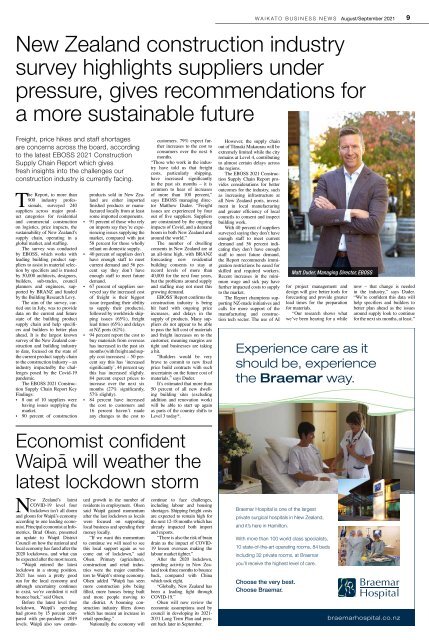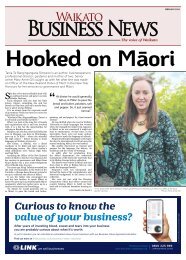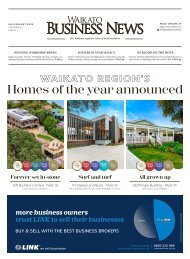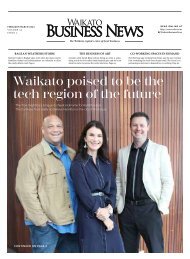Waikato Business News August/September 2021
Waikato Business News has for a quarter of a century been the voice of the region’s business community, a business community with a very real commitment to innovation and an ethos of co-operation.
Waikato Business News has for a quarter of a century been the voice of the region’s business community, a business community with a very real commitment to innovation and an ethos of co-operation.
You also want an ePaper? Increase the reach of your titles
YUMPU automatically turns print PDFs into web optimized ePapers that Google loves.
WAIKATO BUSINESS NEWS <strong>August</strong>/<strong>September</strong> <strong>2021</strong><br />
9<br />
New Zealand construction industry<br />
survey highlights suppliers under<br />
pressure, gives recommendations for<br />
a more sustainable future<br />
Freight, price hikes and staff shortages<br />
are concerns across the board, according<br />
to the latest EBOSS <strong>2021</strong> Construction<br />
Supply Chain Report which gives<br />
fresh insights into the challenges our<br />
construction industry is currently facing.<br />
The Report, to more than<br />
900 industry professionals,<br />
surveyed 240<br />
suppliers across major product<br />
categories for residential<br />
and commercial construction<br />
on logistics, price impacts, the<br />
sustainability of New Zealand’s<br />
supply chain, operating in a<br />
global market, and staffing.<br />
The survey was conducted<br />
by EBOSS, which works with<br />
leading building product suppliers<br />
to assist in material selection<br />
by specifiers and is trusted<br />
by 30,000 architects, designers,<br />
builders, sub-trades, council<br />
planners and engineers, supported<br />
by BRANZ and funded<br />
by the Building Research Levy.<br />
The aim of the survey, carried<br />
out in July, was to provide<br />
data on the current and future<br />
state of the building product<br />
supply chain and help specifiers<br />
and builders to better plan<br />
ahead. It is the largest known<br />
survey of the New Zealand construction<br />
and building industry<br />
to date, focused on the state of<br />
the current product supply chain<br />
to the construction industry – an<br />
industry impactedby the challenges<br />
posed by the Covid-19<br />
pandemic.<br />
The EBOSS <strong>2021</strong> Construction<br />
Supply Chain Report Key<br />
Findings:<br />
• 8 out of 10 suppliers were<br />
having issues supplying the<br />
market.<br />
• 90 percent of construction<br />
products sold in New Zealand<br />
are either imported<br />
finished products or manufactured<br />
locally from at least<br />
some imported components.<br />
• 91 percent of those who rely<br />
on imports say they’re experiencing<br />
issues supplying the<br />
market, compared with just<br />
58 percent for those wholly<br />
reliant on domestic supply.<br />
• 40 percent of suppliers don’t<br />
have enough staff to meet<br />
current demand and 56 percent<br />
say they don’t have<br />
enough staff to meet future<br />
demand.<br />
• 67 percent of suppliers surveyed<br />
say the increased cost<br />
of freight is their biggest<br />
issue (regarding their ability<br />
to supply their products),<br />
followed by worldwide shipping<br />
issues (65%), freight<br />
lead times (65%) and delays<br />
at NZ ports (62%).<br />
• 94 percent report the cost to<br />
buy materials from overseas<br />
has increased in the past six<br />
months (with freight and supply<br />
cost increases) – 50 percent<br />
say this has ‘increased<br />
significantly’, 44 percent say<br />
this has increased slightly.<br />
84 percent expect prices to<br />
increase over the next six<br />
months (27% significantly,<br />
57% slightly).<br />
• 84 percent have increased<br />
the cost to customers and<br />
16 percent haven’t made<br />
any changes to the cost to<br />
customers. 79% expect further<br />
increases to the cost to<br />
consumers over the next 6<br />
months.<br />
“Those who work in the industry<br />
have told us that freight<br />
costs, particularly shipping,<br />
have increased significantly<br />
in the past six months – it is<br />
common to hear of increases<br />
of more than 100 percent,”<br />
says EBOSS managing director<br />
Matthew Duder. “Freight<br />
issues are experienced by four<br />
out of five suppliers. Suppliers<br />
are constrained by the ongoing<br />
impacts of Covid, and a demand<br />
boom in both New Zealand and<br />
around the world.”<br />
The number of dwelling<br />
consents in New Zealand are at<br />
an all-time high, with BRANZ<br />
forecasting new residential<br />
building consents to stay at<br />
record levels of more than<br />
40,000 for the next four years,<br />
but the problems around supply<br />
and staffing may not meet this<br />
growing demand.<br />
EBOSS’ Report confirms the<br />
construction industry is being<br />
hit hard with ongoing price<br />
increases, and delays in the<br />
supply of products. Many suppliers<br />
do not appear to be able<br />
to pass the full cost of materials<br />
and freight increases on to the<br />
customer, meaning margins are<br />
tight and businesses are taking<br />
a hit.<br />
“Builders would be very<br />
brave to commit to new fixed<br />
price build contracts with such<br />
uncertainty on the future cost of<br />
materials,” says Duder.<br />
It’s estimated that more than<br />
50 percent of all new dwelling<br />
building sites (excluding<br />
addition and renovation work)<br />
will be able to start up again<br />
as parts of the country shifts to<br />
Level 3 today*.<br />
However, the supply chain<br />
out of Tāmaki Makaurau will be<br />
extremely limited while the city<br />
remains at Level 4, contributing<br />
to almost certain delays across<br />
the regions.<br />
The EBOSS <strong>2021</strong> Construction<br />
Supply Chain Report provides<br />
considerations for better<br />
outcomes for the industry, such<br />
as increasing infrastructure at<br />
all New Zealand ports, investment<br />
in local manufacturing<br />
and greater efficiency of local<br />
councils to consent and inspect<br />
building work.<br />
With 40 percent of suppliers<br />
surveyed saying they don’t have<br />
enough staff to meet current<br />
demand and 56 percent indicating<br />
they don’t have enough<br />
staff to meet future demand,<br />
the Report recommends immigration<br />
restrictions be eased for<br />
skilled and required workers.<br />
Recent increases in the minimum<br />
wage and sick pay have<br />
further impacted costs to supply<br />
to the market.<br />
The Report champions supporting<br />
NZ-made initiatives and<br />
calls for more support of the<br />
manufacturing and construction<br />
tech sector. The use of AI<br />
Matt Duder, Managing Director, EBOSS<br />
for project management and<br />
design will give better tools for<br />
forecasting and provide greater<br />
lead times for the preparation<br />
for materials.<br />
“Our research shows what<br />
we’ve been hearing for a while<br />
Experience care as it<br />
should be, experience<br />
the Braemar way.<br />
now – that change is needed<br />
in the industry,” says Duder.<br />
“We’re confident this data will<br />
help specifiers and builders to<br />
better plan ahead as the issues<br />
around supply look to continue<br />
for the next six months, at least.”<br />
Economist confident<br />
Waipā will weather the<br />
latest lockdown storm<br />
New Zealand’s latest<br />
COVID-19 level four<br />
lockdown isn’t all doom<br />
and gloom for Waipā’s economy<br />
according to one leading economist.<br />
Principal economist at Infometrics,<br />
Brad Olsen, presented<br />
an update to Waipā District<br />
Council on how the national and<br />
local economy has fared after the<br />
2020 lockdowns, and what can<br />
be expected after the most recent.<br />
“Waipā entered the latest<br />
lockdown in a strong position.<br />
<strong>2021</strong> has seen a pretty good<br />
run for the local economy and<br />
although uncertainty continues<br />
to exist, we’re confident it will<br />
bounce back,” said Olsen.<br />
Before the latest level four<br />
lockdown, Waipā’s spending<br />
had grown by 15 percent compared<br />
with pre-pandemic 2019<br />
levels. Waipā also saw continued<br />
growth in the number of<br />
residents in employment. Olsen<br />
said Waipā gained momentum<br />
after the last lockdown as locals<br />
were focused on supporting<br />
local business and spending their<br />
money locally.<br />
“If we want this momentum<br />
to continue we will need to see<br />
this local support again as we<br />
come out of lockdown,” said<br />
Olsen. Primary (agriculture),<br />
construction and retail industries<br />
were the major contributors<br />
to Waipā’s strong economy.<br />
Olsen added “Waipā has seen<br />
more construction jobs being<br />
filled, more houses being built<br />
and more people moving to<br />
the district. A booming construction<br />
industry filters down<br />
which has meant an increase in<br />
retail spending.”<br />
Nationally the economy will<br />
continue to face challenges,<br />
including labour and housing<br />
shortages. Shipping freight costs<br />
are expected to remain high for<br />
the next 12-18 months which has<br />
already impacted both import<br />
and exports.<br />
“There is also the risk of brain<br />
drain as the impact of COVID-<br />
19 lessen overseas making the<br />
labour market tighter.”<br />
After the 2020 lockdown,<br />
spending activity in New Zealand<br />
took three months to bounce<br />
back, compared with China<br />
which took eight.<br />
“Globally, New Zealand has<br />
been a leading light through<br />
COVID-19.”<br />
Olsen will now review the<br />
economic assumptions used by<br />
council in developing its <strong>2021</strong>-<br />
2031 Long Term Plan and present<br />
back later in <strong>September</strong>.<br />
Braemar Hospital is one of the largest<br />
private surgical hospitals in New Zealand,<br />
and it’s here in Hamilton.<br />
With more than 100 world class specialists,<br />
10 state-of-the-art operating rooms, 84 beds<br />
including 32 private rooms, at Braemar<br />
you’ll receive the highest level of care.<br />
Choose the very best.<br />
Choose Braemar.<br />
braemarhospital.co.nz


















